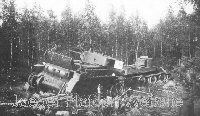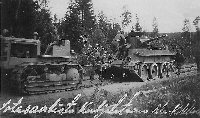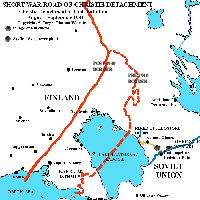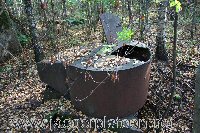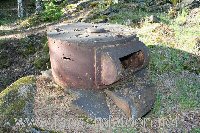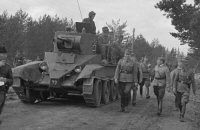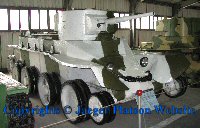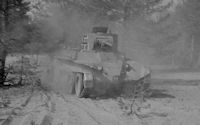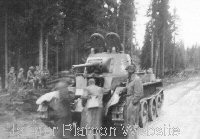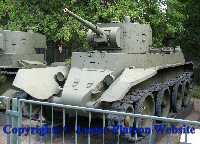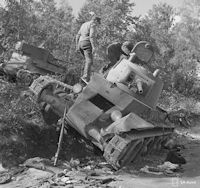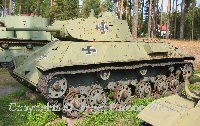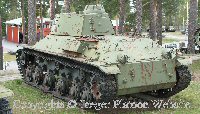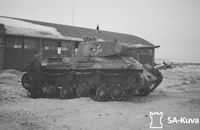FINNISH ARMY 1918 - 1945: BT-5, BT-7 AND T-50 TANKS (original) (raw)
ARMOURED VEHICLES PART 7
BT-5, BT-7 AND T-50 TANKS
As the title above suggests the main subject of this page is the story of captured Soviet BT-5, BT-7 and T-50 tanks in use of Finnish Army. The focus of this page is on BT-5 and BT-7, since they played at least marginal role in Finnish use, while the single Finnish-captured T-50 basically failed to see any real combat use. But since I think that the story of Soviet light tanks and their career in Finnish use would not be full without telling story of T-50, I decided to include it.
Origin of BT-tanks:
By late 1920's the Soviets had come to conclusion that they needed to update their tank fleet. So they went inspecting foreign tank designs and acquiring best of them for the purpose of launching mass production in Soviet Union. One of the most interesting designs that they found was Christie tank developed by rather eccentric American inventor J. Walter Christie. Year 1930 Christie sold two of his M1931 tanks and their manufacturing license to Soviet Union. These two prototypes disguised as agricultural tractors provided the starting point for Soviet development work of BT-tank series. Apparently the Soviets named the two Christie-prototypes as BT-1 tanks. The abbreviation BT (Bystrohodnyi Tank = fast tank) referred as speed of the tank its and intended role as a tank to be used for utilised for fast advance after breaching of enemy defences. Compared to other tanks of that time Christie tank was very much a "race car tank" - very fast and but it also had quite light armour. Best part of Christie design was a suspension system, which when compared to other suspension designs of the same era, allowed notably smooth ride in high speeds. Another unusual feature of Christie tank was that in addition of being used with tank tracks like a normal tank, in a good road it could also be driven on road wheels with chain drive - completely without tracks. However when it came to being a practical armoured combat vehicle, Christie tank still had plenty of room for improvement. First Soviet-designed improved version of Christie tank was BT-2 which had its first prototypes completed already in year 1931. This tank was manufactured with three armament versions, in all of which their whole weaponry was in their turret:
- 3 x 7.62-mm machinegun
- 37-mm PS-3 gun only
- 37-mm PS-3 tank gun and 7.62-mm machinegun
The development work of these tanks continued whole 1930�s and resulted mass-production. Since developing the design continued only about 620 BT-2 were manufactured 1932 - 1933, until it was replaced in production by BT-5, which in turn was replaced by BT-7 in year 1935. While diesel engine equipped BT-7M proved to be end of the line for BT-tank lineage mass-production wise, further developed Christie-suspension went forward and was used in of the best tanks of World War 2 - T-34.
BT-series tanks saw plenty of use with Soviet Red Army in 1930�s, but the Soviets lost grand majority of them in battles following Germany invasion in summer of 1941. Still, relatively small number seems to have remained in Soviet use until end of World War 2. Captured BT-5, BT-7, BT-7M and BT-7A tanks seem to have also seen relatively large-scale use with German military, which called them Pzkw BT 742(r). Besides combat and reconnaissance the Germans used these tanks also for policing of occupied areas and as training vehicles. Christie tank design was also further developed as British cruiser tanks, which were manufactured in large numbers before and during World War 2.
PICTURE: Two knocked out Soviet BT-5 tanks. These two tanks show the two versions of turrets used in BT-5 tanks. (Photo property of Jaeger Platoon Website). CLICK THUMBNAIL TO SEE LARGER PIC (100 KB).
Finnish captured BT-5 and BT-7:
During Finnish - Soviet Winter War (November 1939 - March 1940) Soviet Red Army used BT-2, BT-5 and BT-7 tanks in very large numbers in front north of Lake Laatokka / Ladoga. In huge snow-covered forests of that area they proved rather unsuccessful mainly due to their poor terrain mobility. While the Soviets had somewhat increased armour protection of these tanks during development, with their thin armour they were still easy pray for small number of antitank-guns and antitank-rifles, which Finnish troops had in their use. During Winter War in this area Finnish Army pocketed whole divisions of Red Army units into several motti (pockets). Ultimately the pocketed Red Army units started running out of fuel and spare-parts and were usually forced to turn their tanks as improvised pillboxes by digging them into turret down positions. This was the condition in which Finnish troops destroying Soviet troops one _motti_after another captured these tanks. But even if Finnish troops captured large number of BT-tanks in area north of Lake Laatokka / Ladoga at that time, they were not able to salvage these tanks, since they were lacking proper towing vehicles capable towing off tanks this heavy. One could also note that the condition in which most of the tanks were captured likely increased the difficulty of salvaging them. Soon running out of fuel encircled Soviet units commonly dug their tanks turret deep and used them as improvised pillboxes. Attacking these encircled Soviet units Finnish troops typically knocked out dug in tanks with Molotov cocktails and satchel charges - which tended to make much more damage than antitank-guns or antitank-rifles. Hence much of the tanks captured from numerous motti were basically burned or blown up hulks, which had been dug on frozen ground - far from ideal starting point for salvage operation. Hence only weapons and other useful tank parts were evacuated and after Winter War Finnish Army still did not have any complete BT-series tank in its inventory.
Once Finnish - Soviet Continuation War started in summer of 1941 this soon changed. Soviet troops were still using BT-series tanks and now advancing Finnish Army was able to capture number of BT-5 and BT-7 tanks either undamaged or with so little damage, that they could be swiftly repaired and pressed into own use. Still the career of these tanks with Finnish Army proved to be very short. At that time the de facto standard tank of Finnish Army was T-26, which was smaller, much slower, had slightly weaker armour and similar weaponry. Hence checking only the performance on paper, Finnish lack of interest towards BT-5 and BT-7 tanks might look surprising. The main reason for this lack of interest seems to have been practical experience gained with captured BT-5 and BT-5 tanks in summer - autumn of 1941, but more on that later.
PICTURE: Finnish soldiers are salvaging captured BT-7 m 1935 tank. The towing tractor that they are using is McCormick TD-14. (Photo source Pala Suomen Historiaa website). CLICK THUMBNAIL TO SEE LARGER PIC (114 KB).
Christie Detachment of Heavy Tank Platoon:
Due to origin of the tank design Finnish soldiers commonly called BT-series tanks with nickname "Christie". The main user in Finnish Army for BT-5 and BT-7 tanks was Raskas Panssarijoukkue (Heavy Tank Platoon) of Panssaripataljoona (Tank Battalion) in year 1941. When Continuation War started in June of 1941 this unit was equipped with two T-28 tanks and two T-26 tanks (R-81 and R-82). That summer Finnish Army launched offensive, which re-captured areas lost in Winter War (1939 - 1940) and advanced deep to Soviet Carelia. August of 1941 advancing Finnish troops captured several BT-5 and BT-7 tanks almost or completely intact and these tanks were handed over to Tank Battalion. For the purpose of re-issuing them to its own use Tank Battalion re-organised its Heavy Tank Platoon transferring T-26 tanks of this platoon to 1st and 3rd Tank Companies and creating new unit simply named Christie-Osasto (Christie Detachment) to this platoon. Christie Detachment of Heavy Tank Platoon was created in 13th of August 1941 and received four BT-5 and BT-7 tanks to its use in 13th - 14th of August 1941 and one additional BT-series tank in 18th of August 1941. With these five tanks the detachment was considered complete. Finding personnel for this new unit proved somewhat difficult. Luutnantti (Lieutenant) O. Keskinen became commander of this Detachment with vänrikki (2nd Ltn) Järvenpää as his second in command. But finding enough trained tank crews for all newly captured BT-tanks proved more problematic. The Tank Battalion had some extra trained tank crew members which got transferred to Christie Detachment, but run out of spare men after the fourth tank. Fortunately this problem was solved already the next day, when 3 NCO and 7 men transferred from recently abolished 7. Panssariautojoukkue (7th Armoured Car Platoon) arrived to Tank Battalion and some of them became crew of the fifth BT-tank used by Christie Detachment.
Vehicles of Heavy Tank Platoon of Tank Battalion 1st of September 1941:
- 2 x T-28 tank
- 3 x BT-5 tank
- 2 x BT-7 tank
- 4 trucks (maintenance truck, ammunition truck, fuel truck and supplies truck)
- 1 passenger car
MAP: The short war road of Christie Detachment in August - September 1941. CLICK THUMBNAIL TO SEE LARGER PIC (174 KB).
Apparently the five BT-tanks taken to use of Christie Detachment included three BT-5 tanks and two BT-7 tanks. This detachment was unusual for Finnish Army in one sense - unlike other Finnish tank units it used escorting infantry in manner closely resembling Soviet tank riders. During Continuation War Finnish Army preferred infantry to fight along tanks was bicycle infantry of Jaeger Battalions, which had received specialist training for this task and moved to battle either on bicycles (dismounting for battle) or on foot. On the other hand T-26 tank, which was the most common tank in Finnish use, had relatively small rear deck, so there was not much room for tank riders on it. Anyway, 22nd of August 1941 Christie Detachment got its own separate unit of escorting infantry created from men of Kevyt Osasto 4 (Light Detachment 4), which was bicycle infantry unit. Each BT-5 and BT-7 tank of the Christie Detachment received a rifle squad of NCO + 6 men that were trained ride to battle on rear deck of the tank and dismount for battle. Training of these tank riders started 21st of August.
Finnish troops advancing on northern shore of Lake Laatokka / Ladoga had stopped for about a month to River Tuullosjoki, on whose eastern bank the Soviet troops had dug-in. 4th of September 1941 Finnish units in this area crossed Tuullosjoki River and started their attack towards River Syväri / Svir. Leading the attack was Tank Battalion for which this was the first real battle in Continuation War. That day also Christie Detachment entered to battle supporting Light Detachment 4 starting around 16:40. Attacking with Christie Detachment were the T-28 tanks also belonging to Heavy Tank Platoon. The muddy terrain caused problems right away with two of the BT-tanks of Christie Detachment getting stuck � they were left behind with rest of the tanks continuing the attack. For a while the attack went smooth. Fighting against Soviet infantry in only 20 minutes Heavy Tank Platoon reached Tuullos - Aunus main road, but then run into Soviet defence around 19:30. The tank platoon destroyed several Soviet antitank-guns, three field guns and armoured car. Both T-28 tanks of Heavy Tank Platoon were hit and were put out of action for a while.
In early hours of 5th of September 1941 two tanks of Christie Detachment were sent to chase the retreating enemy troops. The two tanks were sent to attack without escorting infantry, which turned out to be a serious mistake. Soviet antitank-gun scored hits to both tanks with BT-7 R-100 suffering most damage. It was set on fire and its whole crew lost. The battles continued and so did the advance. 7th of September Heavy Tank Platoon arrived to Aunus and continued from there towards River Syväri / Svir. 13th - 14th of September on Kinkinevo road near Syväri / Svir power plant all remaining tanks of Christie Detachment either broke down or got stuck. They were dragged from mud and repaired back into running order, but by now were in such a worn shape, that they needed complete overhaul and extensive repairs.
Report written by Lieutenants Keskinen and A. Räsänen about the four BT-tanks remaining in use of Christie Detachment gives pretty clear picture about their condition. According report the four tanks were in such a poor shape, that while one fault was repaired, another place would already fall apart. Tracks of all tanks were worn and had become stretched in such extent, that they were repeatedly falling off. Transmissions were worn to such level that some gears simply no longer stayed on. Their motors were running poorly and steering did not work properly in any of the tanks. Two of the tanks had broken starter engines, wiring needed to be checked in all tanks and at least two tanks had parts missing from their periscope mounting. Main clutch in two of the tanks needed to be checked and some road wheels replaced. Repairing such wide array of technical problems in the field was impossible. Hence 16th of September 1941 all remaining four BT-tanks were sent to Armour Centre Repair Shop in town of Varkaus for complete overhaul. The next day Christie Detachment was abolished, since it no longer had any tanks and its men were transferred to other units of Tank Battalion. This was the end for a short-lived career of BT-5 and BT-7 in active combat use tanks with Tank Battalion. However it must he noted that this was not the complete end for use of use of BT-5 and BT-7 in Finnish Army. Apparently three BT-5 tanks and two BT-7 tanks used by Christie Detachment were not the only tanks of these types used by Tank Battalion that year. According reports armoured vehicles in of 1st Tank Company of Tank Battalion in November - December 1941 included two operational BT-series tanks. Tank inventory report from 15th of March 1942 inventory still shows 1st Tank Company still having one of these tanks, which at that time was commanded to Nurmoila. However nothing suggest that BT-5 and BT-7 tanks taken to Finnish use would have seen any combat use after abolishing of Christie Detachment. Apparently using of BT-series tanks in Tank Battalion ended sometime early 1942.
Other Finnish users and uses:
Christie Detachment of Tank Battalion was not the only unit of Finnish Army to use BT-series tanks. In addition in October of 1941 Tank Battalion traded two BT-5 tanks in exchange of one T-28 tank, which had been in use of Armour Detachment (Panssariosasto) of 1st Division. Presumably these two BT-5 tanks may have seen combat use with Armour Detachment of 1st Division at that time, but their career proved brief, since this unit handed over its tanks already in early November of 1941. Lacking a proper mobile repair shop and trained tank mechanics Armour Detachment of 1st Division had been able to keep its tanks in running order only for a very limited time. The two BT-5 tanks traded to this unit may have been recently captured tanks taken to Finnish use without large-scale repairs, since apparently they were already in rather poor shape when traded. By the time 1st Division handed over tanks of its Armour Detachment and abolished this unit, both BT-5 tanks had suffered so extensive mechanical problems, that both of them had to be towed off.
PICTURE: Teräspesäke 37 - Salpa-line gun placement build from BT-2 tank turret. The 37 Psv.K/36 tank gun used in these turrets have been removed. CLICK THUMBNAIL TO SEE LARGER PIC (223 KB).
PICTURE: Teräspesäke 45 - Salpa-line gun placement build from BT-5 tank turret. As usual weapons have been removed from this turret. CLICK THUMBNAIL TO SEE LARGER PIC (216 KB).
Year 1941 Finnish Army captured also rather large number of BT-2 tanks, but none of these was taken to Finnish use. According inventory made in Armour Centre Repair Shop in June of 1943, there were still 15 of these BT-2 tanks waiting scrapping even at that time. Since Finnish Army did not bother taking BT-series tanks to its own use in large numbers, they became available for other projects. Often these damaged tanks had no real damage, which would have inhibited use of their turrets. Year 1944 turrets taken from BT-2, BT-5 and BT-7 were hastily installed as gun placements in defence line called Salpa-line (Salpa-linja). This defence line was located west of year 1940 Finnish-Soviet border and building it had started after Winter War. When used in this way tank turret and section of the tank hull under it was removed from the damaged tank and delivered to the defence line. There a suitable hole on the ground had been prepared for it (wood and stone structures were sometimes used to provide additional support). Turret with the hull section under it was lowered to this hole - creating a small two-man bunker with rotating gun turret. Bunker with BT-2 turret used this was named teräspesäke 37 (steel gun placement 37) and equipped with 37 Psv.K/36tank gun, which had been left over from Vickers 6-ton tanks, when they had been modified as T-26E after Winter War. BT-5 and BT-7 turrets used in this manner were called teräspesäke 45(steel gun placement 45) and equipped with standard Soviet 45-mm Psv.K tank gun and coaxial 7.62-mm DT machinegun. From the turrets used BT-5 turret was far more common than BT-7 turret. Typically these bunkers were placed in such positions, that they were able to provide flanking fire. By standards of year 1944 both gun placements and the tank-guns used in them were obsolete, but still better than having nothing. Since the Soviets never reached Salpa-line, these gun placements never faced the ultimate test - combat.
BT-5
PICTURE: BT-5 tank R-99 of Christie Detachment with escorting infantry from Light Detachment 4 on its deck passes entourage of Major General Paavo Talvela. The officer belonging to entourage that is having a discussion with tank commander is Colonel Ruben Lagus, commander of Tank Battalion. Photo taken by Military Official Teuvo Tulio in Vitele August of 1941. (SA-kuva photo archive, photo number 43880). CLICK THUMBNAIL TO SEE LARGER PIC (177 KB).
| Weight: | 11.5 tons |
|---|---|
| Length: | 5.58 meters |
| Width: | 2.23 meters |
| Height: | 2.25 meters |
| Max. Speed: | 53 km/h on road with tracks |
| 72 km/h on road with road wheels | |
| 20 km/h off road (with tracks) | |
| Engine: | 400hp M-5 12-cylinder gasoline engine |
| Armour: | 6 - 40 mm |
| - Turret front | 20 mm |
| - Turret sides and rear | 15 mm |
| - Hull front upper part | 13 mm |
| - Hull front lower part | 30 mm / 40 mm |
| - Hull sides and rear | 13 mm |
| - Turret top and hull deck | 10 mm |
| - Hull bottom | 6 mm |
| Ground Clearance: | 35.0 cm |
| Ground Pressure: | 0.54 kg/square cm |
| Gradient: | 37 degrees (with tracks) |
| 15 degrees (on road wheels) | |
| Trench: | 2.39 m |
| Fording: | 0.9 m |
| Range: | 150 km with tracks on road / 200 km on road wheels |
| Weapons: | 45 mm Soviet (L/45) tank gun (115 or 75 rounds) (*) |
| 7.62 mm DT coaxial machinegun (2,709 rounds) (*) | |
| Crew: | 3 men |
| Country of Origin: | Soviet Union |
| Production: | 1933 - 1934, total number manufactured about 1,900 tanks. |
(*) Depending if equipped with radio or not, radio took some space otherwise used for ammunition.
Finnish use: Finnish Army units used small number of captured BT-5 tanks in 1941 - 1942.
Like earlier BT-2, also this tank was developed and manufactured in Kharkiv Locomotive Factory (KhPZ). The design team developing the both tanks was lead by A.O. Firsov and the tank design was completed in year 1932. Manufacturing started in summer of 1933 and continued until replaced in manufacturing by BT-7 in late 1934. Considering short duration of the time of manufacturing, surprisingly about 1,900 tanks were manufactured in that short period of time. The most obvious improvement of BT-5 over earlier BT-2 was new larger turret, which was armed with 45-mm tank gun and coaxial 7.62-mm DT machinegun. Two variants of this new turret manufactured for BT-5 tanks and their visible main difference is size of the turret rear bulge. Other notable improvements were made to hull, suspension and running gear, which was equipped with new stronger driving wheels. The tank had crew of three men - driver, gunner and loader/tank commander. 400-horsepower liquid-cooled M-5 gasoline engine was development based to American Liberty L-12 aircraft-engine. Sources suggest that some late manufactured BT-5 may have already been equipped with M17-T engines, which were later used in BT-7 tanks. Transmission used with M-5 engine had four forward gears and reverse.
This tank had a riveted hull and turret, inside which two (gunner and loader/tank commander) were located. Driver was seated centre inside front hull. Two versions of the tank turret were used with the early version having notably narrower bulge on rear of the turret. Optical equipment was rather similar to those used in T-26 m 1933 tanks - TSFM optical sight was used with main gun and coaxial machinegun while PT-1 periscope was mainly used for spotting targets. Optical equipment was pretty poor with very limited view of vision and especially periscope was unsuited for estimating distances. While suspension was highly developed for the time when it was introduced, the off-road mobility capabilities of BT-5 were rather poor. The tank was remarkably fast on road and especially so when chain-driven on road wheels (without tracks). But converting the tank from tracks to road wheels or otherwise was a rather complex process, which could not be done in matter of minutes - some sources suggest that this routinely took at least half an hour. Also as to be expected the tank could be driven on road wheels only on good roads and in this mode the tank had basically zero off-road mobility. New reinforced pressed road wheels replaced older cast road wheels during manufacturing and were installed also to already manufactured tanks.
PICTURE: BT-5 tank without tracks and painted with Soviet winter camo pattern. This particular individual was not used by Finnish military, but it is exactly the same model that saw Finnish use. Notice front hull armour with bulge for driver, which makes identifying BT-5 easy. (Photo taken in Kubinka Tank Museum, Russia). CLICK THUMBNAIL TO SEE LARGER PIC (145 KB).
In typical Soviet period manner only command tanks intended for company and battalion commanders were equipped with radios. The radio-equipped BT-5 tanks had 71-TK-1 radios with their frame antennas around tank turret, but at least some were equipped with TKU-3 interphone system. Rather surprisingly BT-5 tanks were not first used in war by the Soviet Red Army, but by Republican Spain, for which the Soviets delivered 100 BT-5 tanks during Spanish Civil War (1936 - 1939). Year 1939 the Soviets also had two tank brigades equipped with BT-5 taking part in battle of Khalnin-Gol against the Japanese. They also saw extensive use and suffered heavy losses during Finnish - Soviet Winter War in 1939 - 1940. June of 1941 just before Germany launched its offensive to Soviet Union Red Army operated almost 900 of BT-5 tanks, grand majority of which were lost in first few months of the war. After this large number of the remaining BT-5 were apparently concentrated to Finnish - Soviet front, where the war had changed into trench-war after Finnish offensive, that ended in December of 1941. The last operations in which Red Army used BT-5 tanks was against Japanese military during Soviet invasion of Manchuria in August of 1945. German military called both captured BT-5 and BT-7 taken to their own use as Panzerkampfwagen BT 742(r). The Germans used them mainly for reconnaissance, policing occupied areas and training.
As noted, Finnish Army captured large number of BT-5 tanks during Winter War (November 1939 - March 1940), but mainly due to lacking proper towing vehicles were unable to salvage any at that time. Hence when Continuation War started in June of 1941 there were no captured BT-5 in Finnish use at that time, but during first months of the Continuation war (1941 - 1944) Finnish Army again captured large number of BT-5 and this time few of these tanks were taken to Finnish use. But even still their role remained very marginal in Finnish use. Only handful of BT-5 tanks saw use with Finnish Army and their brief career in Finnish Army reached only from August of 1941 to November of 1941. Their most active user was Christie Detachment (Christie Osasto) of Tank Battalion, which had three BT-5 tanks in its use in August - September of 1941. These three tanks had tank registry numbers R-96, R-97 and R-99.
PICTURE: Photograph showing BT-5 tank R-97 of Christie Detachment during rehearsals for attack in Tuullos. This photograph gives good idea about speed of BT-5 tanks. Photo taken by Military Official Teuvo Tulio in Vitele August of 1941. (SA-kuva photo archive, photo number 40985). CLICK THUMBNAIL TO SEE LARGER PIC (117 KB).
During the few months that they had been used, Finnish tank crews had gained less than favourable experiences of these tanks. Their technical reliability was notably poorer than with T-26 tanks, which at that time were de-facto standard tanks of Finnish Army. Tank tracks of BT-5 tanks had notable tendency of coming off in sharp turns or in difficult terrain and apparently this was one of the major problems with the design. Technical issues combined with the very high fuel consumption were the main reason why Finnish Army had so little interest towards these tanks. All through World War 2 Finland was suffering gasoline shortage, so fuel consumption was important factor in decision making. Poor mobility in deep snow and limited number of captured BT-5 tank fit for repair may have also effected the decisions. Apparently there were enough captured BT-5 that a tank company could have been equipped, but equipping a whole tank battalion would have been difficult or impossible. June of 1943 inventory was made of captured Soviet tanks, which had not been taken to Finnish use. According that inventory listing at that time Finnish Army had 62 captured BT-5 tanks, which had been evacuated to Armor Centre repair facility. From those 62 tanks, 21 could have been repaired if necessary and 41 were considered too severely damaged for repairing them to be efficient. When new armour registry number system was created in summer of 1943, registry number series Ps. 176 was still reserved to be used in BT-5 tanks issued to Finnish use, but this proved unnecessary. Ultimately all remaining captured BT-5 tanks were scrapped.
BT-7
BT-7 model 1935 and BT-7 model 1937
PICTURE: Finnish soldiers with captured BT-7 m 1937 tank. Considering at least one of them is wearing typical tank crew clothing, overalls and leather tank helmet, this tank may have been in Finnish use when this photo was taken. (Photo property of Jaeger Platoon Website). CLICK THUMBNAIL TO SEE LARGER PIC (71 KB).
| Weight: | 13.8 tons (m 1935) / 13.9 tons (m 1937) |
|---|---|
| Length: | 5.66 meters |
| Width: | 2.23 meters |
| Height: | 2.42 meters |
| Max. Speed: | 50 km/h on road with tracks |
| 72 km/h on road with road wheels | |
| 35 km/h off road (with tracks) | |
| Engine: | 500hp M-17T 12-cylinder gasoline engine |
| Armour: | 6 - 20 mm |
| - Turret front | 15 mm |
| - Turret sides and rear | 15 mm |
| - Hull front upper part | 20 mm |
| - Hull front middle part | 15 mm |
| - Hull front lower part | 20 mm |
| - Hull sides | 15 mm |
| - Hull rear | 10 mm / 13 mm |
| - Turret top & hull deck | 10 mm |
| - Hull bottom | 6 mm |
| Ground Clearance: | 39.0 cm |
| Ground Pressure: | 0.65 kg/square cm |
| Gradient: | 37 degrees (with tracks) |
| 15 degrees (on road wheels) | |
| Trench: | 2.00 m |
| Fording: | 0.9 m |
| Range: | 375 km with tracks on road / 500 km on road wheels |
| Weapons: | M 1935: 45 mm Soviet (L/45) tank gun (172 or 132 rounds) (*) |
| M 1937: 45 mm Soviet (L/45) tank gun (188 or 146 rounds) (*) | |
| 7.62 mm DT coaxial machinegun (2,394 or 1,953 rounds) (*) | |
| Crew: | 3 men |
| Country of Origin: | Soviet Union |
| Production: | 1935 - 1939, total number manufactured about 4,600 tanks. |
(*) Depending if equipped with radio or not, radio took some space otherwise used for ammunition.
Finnish use: Finnish Army used at least two of these captured tanks in year 1941. Starting autumn of 1942 Finnish industry converted 18 of these tanks in to BT-42 assault guns.
As to be expected BT-7 tank was further development based to earlier BT-5 tank. First version of BT-7 is known as BT-7 model 1935. Just like its predecessor BT-5 also BT-7 was designed and manufactured in Kharkiv Locomotive Factory (KhPZ). First prototype was manufactured in November 1934 and mass-production started in year 1935. It was mass-produced in far larger numbers than previous BT-tank designs. Mass-production of this tank did not end until year 1939 and total production number of BT-7 tanks was around 4,600 tanks. Unlike its predecessor it had cast hull, new improved turret and larger fuel capacity. New tracks introduced with this tank model had larger number of smaller track links. Also previous engine had been replaced with 500 horsepower liquid-cooled M-17T gasoline engine, which was one of the Soviet build tank engines based to German BMW V1 aircraft engine. For starting the engine the vehicle had two magnetos and some could also be started with pressurised air. The tank had crew of three men, from which gunner and loader/tank-commander were inside turret and driver was sitting centre of front hull. Weaponry-wise the tank was equipped with usual Soviet tank weapons of that time - 45mm tank gun and 7.62-mm DT-machinegun(s). All BT-7 had DT coaxial machinegun, but some had also rear-turret machinegun and/or anti-aircraft machinegun of similar model. Also usual Soviet manner of 1930's only command tank version of tank was equipped with radio - the radio used in them was 71-TK-3. At least some of the tanks had also primitive TKU-3 interphone system. Year 1937 BT-7 model 1935 replaced in manufacturing with BT-7 model 1937. The main improvement of BT-7 model 1937 was replacing the original BT-7 with a new conical turret model, which provided better protection and allowed more ammunition to be carried inside the vehicle. Other improvements introduced during manufacturing included added two searchlights on top of main gun and 7.62-mm DT antiaircraft machinegun on top of the turret in P-40 mount, both of these were introduced in year 1937. Additional fuel tanks allowed much longer operational range for this tank. Also the less then spectacular original 3-gear gearbox was replaced with new 4-gear gearbox that same year. Optical equipment included PT-1 periscope and TOP gun sight for main gun and coaxial machinegun.
PICTURE: Soviet BT-7 model 1935 tank. This particular individual was not used by Finnish military, but it is exactly the same model that saw Finnish use. Notice shape of front hull armour and conical turret. (Photo taken in Central Museum of Russian Armed Forces, Moscow Russia). CLICK THUMBNAIL TO SEE LARGER PIC (189 KB).
Besides normal BT-7 tanks, the KhPZ manufactured also some special versions of this tank for the Soviets, most important these were BT-7A and BT-7M. BT-7A was artillery vehicle version, that had different cylindrical turret design equipped with 76-mm KT-28 main gun and three 7.62-mm DT machineguns (coaxial, rear turret and anti-aircraft). Only 155 of BT-7A were manufactured during its whole production in 1936 - 1937. December of 1939 they also introduced BT-7M tank, which was equipped with new 500 horsepower V-2 diesel engine. Some 790 BT-7M tanks were manufactured in 1939 - 1940, until production capacity was transferred into making T-34 medium tanks. Finnish Army did not use either of these special versions. Also BT-7 tanks saw use in Soviet - Japanese battle of Khalkin Gol in 1939, Finnish - Soviet Winter War in 1939 - 1940. Just before Germany launched its offensive to Soviet Union in June of 1941 Soviet Red Army was operating some 3,200 BT-7, BT-7A and BT-7M tanks, much of which were lost during the first few months of this war. Just like BT-5 apparently also large number of BT-7 were after this concentrated to Finnish - Soviet front, where after ending of Finnish offensive in December of 1941 the fighting had turned into a trench war. The last time that the Soviets used BT-7 in combat operations was during their offensive to Japanese occupied Manchuria in August of 1945. German military knew both captured BT-5 and BT-7 taken to their own use as Panzerkampfwagen BT 742(r). The Germans used them mainly for reconnaissance, policing occupied areas and training.
As mentioned Finnish Army did not take BT-7 tanks to its own use until summer of 1941. Apparently the short-lived Christie Detachment (Christie Osasto) of Tank Battalion had two BT-7 tanks in their use in August - September 1941. From these two tanks one was model 1935 and another one model 1937. The model 1937 tank R-100 was lost in battle already 5th of September, when it was knocked out by Soviet antitank-gun during battle of Tuullos. Due to broken fuel pump R-100 had carried a fuel drum on its rear deck and once this was hit the tank burned resulting complete loss. The lone BT-7 model 1935 was among the tanks of Christie Detachment to get stuck or broke down in 13th - 14th of September and sent to Armour Centre Repair Shop 16th of September, but never returned to active service. This ended the career of BT-7 tanks in Finnish use.
The short time BT-7 was used by Finnish Army was enough to convince Finnish soldiers, that this tank design was rather poorly suited to Finnish conditions - much for the same reasons as with BT-5. Technical reliability proved poor, fuel consumption of M-17T gasoline engine excessive and the engine needed extensive overhaul after every 200 hours of use. At that time the most common tank in Finnish use was captured T-26, which had GAZ T-26 engine that also required extensive overhaul after only every 250 hours of use - but compared to this mere 200 hours of use for M-17T looked even worse. Hence Finnish Army decided not to repair BT-7 tanks in to its use. Also just like with BT-5 apparently also BT-7 has tendency of often dropping off its track during tight turn in high speed or in difficult terrain.
PICTURE: Finnish soldiers inspect one of the BT-7 tanks knocked out by troops of Jaeger Battalion 6. Photo taken by Lieutenant Pekka Kyytinen in Onkamus in September of 1941. (SA-kuva photo archive, photo number 43902). CLICK THUMBNAIL TO SEE LARGER PIC (177 KB).
But this decision proved only temporary and later in year 1942 captured BT-7 gained new possibility of getting to Finnish use. Finnish Army did not have too many tanks and the most common tank in Finnish use (T-26) was fast becoming obsolete due to swift wartime technical development of tanks, but finding available tanks was difficult. Finland lacked domestic heavy industry capable manufacturing tanks or even their engines and in middle of world war finding any country willing to sell modern tanks at reasonable terms was not exactly easy. Hence Finnish military started searching ways of utilising existing numerous captured armoured vehicles, which had not yet been taken to own use. Since BT-7 was the most technically advanced of tanks captured in large numbers and not currently in use of Finnish Army, it was a natural starting point for such project. According inventories made in June of 1942 at that time to Armour Centre Repair Shop in Varkaus had 53 captured BT-7 tanks, which were considered suitable to be repaired. The best of these were selected for BT-42 assault gun project. Total number of BT-42 assault guns build in Finland was only 18 and they were all built in 1942 - 1943. It might be worth noting that while Finnish Army considered BT-42 to be assault gun, from technical point of view they could be considered as self-propelled artillery piece. BT-42 had BT-7 hull with much larger Finnish turret designed and built by Valtion Tykkitehdas (State Artillery Factory). This new box-shaped larger turret was used to accommodate 114 Psv.H/18 howitzer. During battles of summer 1943 BT-42 assault guns proved less than successful and were declared obsolete already 7th of July 1944. Year 1943 decision was also made to build BT-43 armoured transport vehicles capable transporting infantry and supplies from captured BT-7 tanks - ultimately this resulted building of only one prototype (Ps.611-1), which was scrapped after testing. Also the last three captured BT-7 tanks waiting for possible repairs were scrapped in year 1945. Unfortunately none of the Finnish-captured BT-7 survived for museum use, but luckily one BT-42 (Ps. 511-18) has survived to this day and is now in collections of Parola Armour Museum. Apparently Finnish Army did not likely ever capture any BT-7A or BT-7M tanks and there is absolutely no evidence about them ever being used by Finnish military, so unlike some sources claim they apparently did not see any Finnish use.
T-50
PICTURE: T-50 tank R-110. Notice additional armour in front hull and turret side.(Photo taken in Panssarimuseo). CLICK THUMBNAIL TO SEE LARGER PIC (184 KB).
| Weight: | 14.5 tons (*) |
|---|---|
| Length: | 5.30 meters |
| Width: | 2.47 meters |
| Height: | 2.17 meters |
| Max. Speed: | 37.5 km/h on road (**) |
| 25 km/h off road | |
| Engine: | 300hp V-4 6-cylinder diesel engine |
| Armour: | 12 - 51 mm (***) |
| - Turret front | 37 mm |
| - Turret sides | 37 mm + 14 mm of additional armour |
| - Turret rear | 15 mm |
| - Hull front upper part | 37 mm + 14 mm of additional armour |
| - Hull front lower part | 45 mm |
| - Hull sides | 37 mm |
| - Hull rear | 25 mm / 37 mm / 30 mm |
| - Turret top and hull deck | 15 mm |
| - Hull bottom | 12 mm / 15 mm |
| Ground Clearance: | 35.0 cm |
| Ground Pressure: | 0.65 kg/square cm |
| Gradient: | 45 degrees |
| Trench: | 2.20 m |
| Fording: | 1.1 m |
| Range: | 340 km with on road / 245 km off-road |
| Weapons: | 45 mm Soviet (L/45) tank gun (150 rounds) |
| 2 x 7.62 mm DT coaxial machinegun (4,000 rounds) | |
| Crew: | 4 men |
| Country of Origin: | Soviet Union |
| Production: | 1941 - 1942, total number manufactured 69 tanks. |
(*) The sole Finnish-captured T-50 was equipped with additional armour and the information here is for that. Weight of basic T-50 (without additional armour) was 13.8 tons.
(**) Tested maximum speed for Finnish-captured T-50 tank with additional armour. Maximum speed on road for basic (without additional armour) T-50 tank was 52 km/h.
(***) Maximum armour for normal T-50 without additional armour was 37-mm.
Finnish use: One T-50 tank was captured in year 1941. Finnish Army used it in 1942 - 1944.
In late 1930's Soviet Red Army came to conclusion that T-26 tanks, which at that time it was using in massive numbers, were too vulnerable to existing antitank-weapons. To fix the situation developing of new light tank designs were ordered in August of 1938. Two factories in Leningrad, Kirov Factory number 185 and Voroshilov Factory number 174, developed prototypes, to which T-50 tank was based. It was officially approved in use of Soviet Red Army in February of 1941. This tank was a completely new design, which was not directly based to any of the previous Soviet tanks, but shared some similarities with T-34 medium tank. Obviously it was the most highly evolved of Soviet light tank designs that far. Due to its thicker and well-sloped armour it sported far better armour protection than any previous Soviet light tank.Weapons that it was equipped with were the usual for Soviet tanks of this size at that time, 45-mm tank gun and coaxial 7.62-mm DT-machinegun or two depending exact manufacturing variation, but unlike previous Soviet light tanks all T-50 were equipped with 9R radio and TPU-3 interphone systems. Both its hull and turret were welded. This tank was the first Soviet light tank to have four-man crew with three of the crewmembers inside turret. This crew-arrangement allowed tank commander to concentrate only into commanding the tank and using the radio. However the turret was also quite crowded for three-man crew. As expected also optical equipment was better than in any previous Soviet light tanks. It also had a new liquid-cooled 300-horsepower V-4 diesel engine and excellent running gear equipped with internal shock absorbers and independent torsion bar suspension for each road wheel.
PICTURE: Another look to T-50 tank R-110. Notice the hatch in rear turret, it was for entering and exiting the turret, since the commander's observation hatch on top of the turret was large enough only for tank commander to raise his head outside or signalling with flags. (Photo taken in Panssarimuseo). CLICK THUMBNAIL TO SEE LARGER PIC (174 KB).
Originally the Soviets intended to build no less than 14,000 of T-50 tanks, but manufacturing problems and German attack to Soviet Union followed to Soviet decision to evacuate much of their industry behind Ural mountains completely ruined these plans. V-4 diesel engine proved exceedingly difficult to manufacture and largely due to this the mass-production of T-50 never started and instead Soviet industry was ordered to concentrate in manufacturing of T-34 and KV-1 tanks. Apparently T-50 was about as expensive to manufacture as T-34 while the Soviets also noted that reliability of V-4 diesel engine was far from ideal. Ultimately only 69 of these tanks were ever manufactured and only 48 of them equipped with weapons, making it the rarest of Soviet light tank designs approved for mass-production. Voroshilov Factory number 174 succeeded manufacturing about 50 of these tanks in Leningrad year 1941 and after its evacuation to in August of that year Omsk it succeeded assembling 15 additional tanks in 1942, presumably rest of the production were prototypes. Still, this was not the end of the Soviet light tank manufacturing since much easier to manufacture T-60 light tank entered production already in July of 1941. T-60 tank was based to earlier T-40 amphibious tank and some 5,800 of them were manufactured in 1941 - 1943. T-70 light tank based to it was manufactured in even larger numbers - some 8,200 were build in 1942 - 1943.
PICTURE: T-50 tank R-110 in city of Petroskoi / Petrozavodsk in January of 1944. Photographer Military official J.M. Wuorela (SA-kuva photo archive, photo number 145402). CLICK THUMBNAIL TO SEE LARGER PIC (97 KB).
Advancing Finnish troops spotted T-50 tank first time already in July of 1941 and later that same year succeeded capturing one of these rare tanks near Äänislinna/Petrozavodsk. It was one of the fifty tanks manufactured by Voroshilov Factory number 174 in Leningrad. The tank was repaired and taken to use of Finnish Army with tank-registry number R-110 in February of 1942. It was first issued to Heavy Tank Company (Raskas Panssarikomppania) of Tank Battalion, but as part of process expanding Tank Battalion to Tank Brigade it was transferred to 3rd Tank Company of Tank Brigade already in March of 1942. Later it was often used as command tank of the tank company. While the tank crew named their T-50 as "Niki", also nickname for it soon appeared and ended up spreading far and wide. This popular nickname was "Pikku-Sotka" (Small Pochard), which referred to its physical resemblance with larger T-34 medium tank, which Finnish soldiers had already earlier nick-named as "Sotka" (Pochard) after a tugboat of that name. This Finnish-captured tank was equipped with 14-mm thick additional armour plates attached with bolts to front hull and turret sides. It had 45 Psv.K/38 tank gun and two coaxial DT-machineguns. As to be expected maintenance of this one of a kind tank proved difficult, but still it remained in active use until 25th of June 1944. That day it was used as command tank during famous counter-attack of Finnish heavy (medium) tanks from Juustila to Portinhoikka during Tali-Ihantala battles. During this counter-attack the tank suffered serious technical failure (engine-failure), which the mobile repair shops of Tank Brigade were unable to repair. The next day it was sent to Centre Armour Repair Facility in Varkaus and apparently was never repaired. While the line T-50 wasn't in operational condition since June 1944, it still remained in armoured vehicle inventory listings of Finnish Army until year 1955. Nowadays this tank is in Parola Armour Museum.
Finnish troops captured also some later Soviet light tanks in battles of summer 1944. They captured T-60 light tank in Portinhoikka 12th of July 1944 and T-70 tank in Ilomantsi 26th of August 1944, but neither of these two tanks was ever issued to Finnish use. Also these two tanks are now in Parola Armour Museum.
SOURCES:
Esa Muikku ja Jukka Purhonen: Suomalaiset Panssarivaunut 1918 � 1997, The Finnish Armoured Vehicles 1918 - 1997.
Kapteeni P. Hovilainen: Tankkirykmentistä Panssaripataljoonaan 1919 � 1949.
Pekka Kantakoski: Suomalaiset Panssarivaunujoukot 1919 � 1969.
Pekka Kantakoski: Punaiset Panssarit, Puna-armeijan panssarijoukot 1918 � 1945.
Pekka Kantakoski: Panssarimuseo.
Erkki Käkelä: Laguksen miehet, Marskin Nyrkki.
Erkki Käkelä: Panssarikomentajan Päiväkirja.
Reino Arimo: Suomen linnoittamisen historia 1918 - 1945.
Tuokko Kaino: 1. Divisioona 1941-1944.
Suomala Jarmo: Kärkenä Äänislinnaan - Kevyt Osasto 8:n historia.
Mikhail Baryatinskiy: Light Tanks.
Maksym Kolomyjec: Tanks in the Winter War.
Panzerbuch der Tanks, Parts 1 � 3 by Fritz von Heigl
Heigl�s Panzerbuck der tanks, Parts 1 � 3 by O.H. Hacker, R.J. Icks, O. Merker and G.P.v. Zezchwitz.
Soviet Tanks and Combat Vehicles of World War Two by Zaloga and Grandsen.
Booklet: Parolan Panssarimuseo (published 2010).
Booklet: Panssarimuseo (published 1999).
Article: Jatkosodan aikaiset erilliset panssarivaunuyksiköt by V. Kämäri in Panssari magazine vol. 1/1974.
Russian Tanks 1900 � 1970 by John Milsom
Finnish National Archives (Sörnäinen), archive folder T10910.
Finnish National Archives (Sörnäinen), archive folder T10911.
Finnish National Archives (Sörnäinen), archive folder T10929/20.
Finnish National Archives (Sörnäinen), archive folder T10929/23.
Finnish National Archives (Sörnäinen), archive folder T20208/F34 sal.
War Diary of Headquarters of Tank Brigade 10th of June - 31st of July 1944.
War Diary of 6th Tank Company of Tank Brigade (earlier: Heavy Tank Co of Tank Battalion) 17th of June 1941 - 21stof March 1942.
Special thanks to Panssarimuseo (The Parola Armour Museum).
Special thanks to Pala Suomen Historiaa website).
The Russian Battlefield Good site about Soviet tanks.
Last updated 17th of October 2020
Webmaster: JTV jtvalias@hotmail.com
Copyrights (text and graphics): Jaeger Platoon Website. Copyrights of photographs vary on case to case basis and are marked along each picture.



